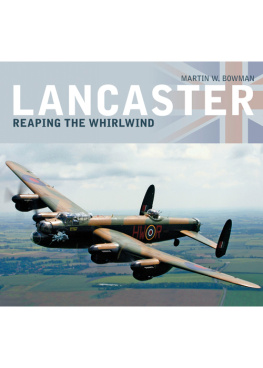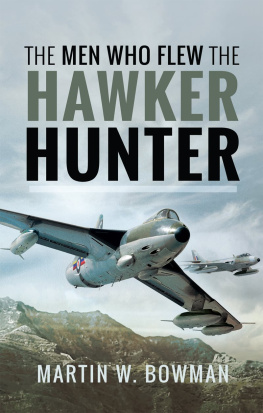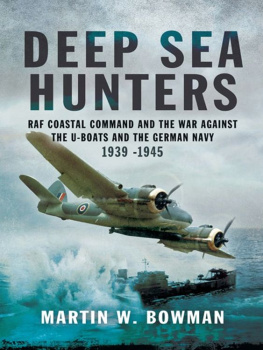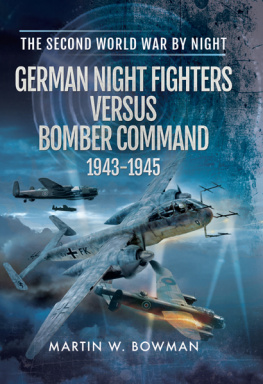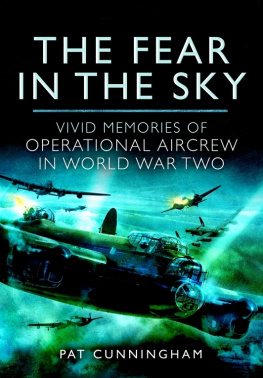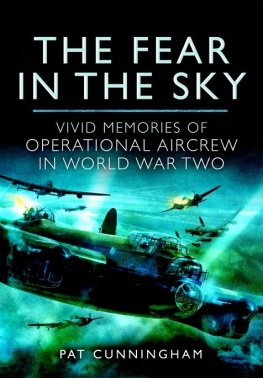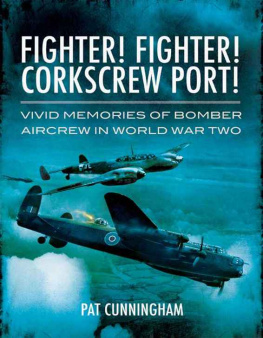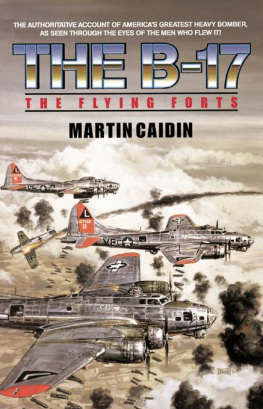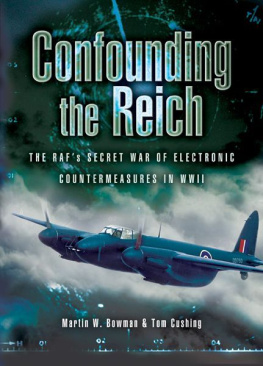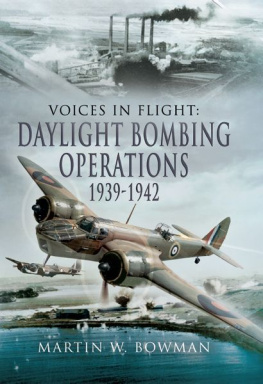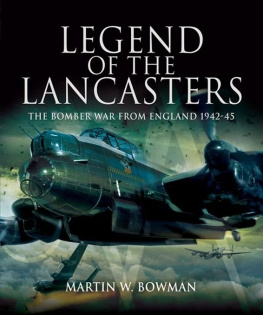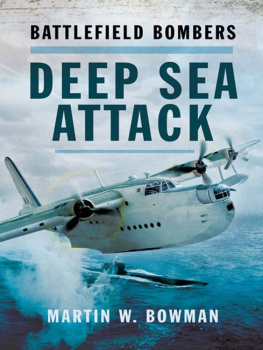First published in
Great Britain in 2006
by Pen & Sword Aviation
an imprint of Pen & Sword Books Ltd
47 Church Street, Barnsley
South Yorkshire, S70 2AS
Copyright Martin W. Bowman, 2006
9781783409341
The right of Martin W. Bowman to be identified as Author of this Work has been asserted by him in accordance with the Copyright, Designs and Patents Act 1988.
A CIP catalogue record for this book is available from the British Library.
All rights reserved. No part of this book may be reproduced or transmitted in any form or by any means, electronic or mechanical including photocopying, recording or by any information storage and retrieval system, without permission from the Publisher in writing.
Typeset by Concept, Huddersfield, West Yorkshire Printed and bound in Great Britain by CPI UK
Pen & Sword Books Ltd incorporates the Imprints of Pen & Sword Aviation, Pen & Sword Maritime, Pen & Sword Military, Wharncliffe Local History, Pen & Sword Select, Pen & Sword Military Classics and Leo Cooper.
For a complete list of Pen & Sword titles please contact
Pen & Sword Books Limited, 47 Church Street, Barnsley,
South Yorkshire, S70 2AS, England
E-mail: enquiries@pen-and-sword.co.uk
Website: www.pen-and-sword.co.uk
Phantom bombers on the old airfields
Where do you fly tonight
Are you off to visit Berlin, Hamburg, Nuremberg or Mannheim
Or somewhere in the Ruhr, east of the Rhine
Phantom bombers on the old airfields
Where do you fly tonight
Through a moonless or full moonlit sky
Giving battle as you fly
Returning shrouded, but with your spirits aces high
Ghostly engines, silenced by time
Outlined at dispersal by rings of rime
With ghostly guns of noiseless rattle
Patiently waiting the phantom hours of battle
Phantom bombers on the old airfields
Where do you fly tonight
If you will only wait for me to join you
In the air battles of long ago
It will be in the company of my old aircrew
The Bomber Airmans Lament (Tune of: Empty Saddles in the Old
Corral ), Louis Patrick Wooldridge DFC
Introduction
I t was an article of faith in the pre-war RAF that modern twin-engined bombers like the Hampden, Wellington, Whitley and Blenheim, with revolving machine-gun turrets and flying in close formation to maximise defensive fire power against attacking fighter aircraft, were unbeatable: The Bomber Always Gets Through. It was even assumed that these aircraft didnt need any form of fighter escort to reach and destroy their assigned targets. In the raw practice of war, however, this belief was rudely shattered. Bomber operations against elements of the German fleet at Brunsbttel and Wilhelmshaven on 4 September 1939 were met with stiff opposition from both fighters and flak, two Wellingtons and five Blenheims being lost. The elderly Whitley squadrons in 4 Group were immediately employed in night leaflet-dropping operations, and made no appearance in daylight at all.
The 3 Group Wellingtons and 5 Group Hampdens kept searching for the German navy in daylight during the remainder of September 1939 but the serious losses inflicted on 29 September, when a complete formation of five 144 Squadron Hampdens were destroyed over the German Bight between Heligoland and Wangerooge Island by Bf 109 fighters, soon convinced the Air Staff that a profound change of its daylight policy was necessary. It was two major disasters in December 1939 that finally persuaded the Air Staff that a radical change in direction was necessary if future bombing operations were to stand any chance of success.
After April 1940 Bomber Command decided not to abandon completely the use of bombers in daylight. Although the Hampden and Wellington units largely shifted to night-time bombing, someone had to do the daylight offensive operations unless the RAF was prepared to admit that it had nothing for this most visible of its tasks. Thus the Bristol Blenheims and Fairey Battles in 2 Group and the AASF (Advanced Air Striking Force) stood forward as the best of a bad lot.
When Bomber Command took the decision in May 1940 to start strategic bombing of Germany by night, there was little the Luftwaffe could do to counter these early raids, as no specialised night-fighting arm existed. The creation of a true night air defence of the Third Reich was dramatically accelerated when Gring ordered General Kammhuber on 17 July 1940 to create a night-fighting arm. By the end of 1940 the infant Nachtjagd had matured into three searchlight batallions and five night-fighter Gruppen . At least nineteen Bomber Command aircraft were destroyed in the Kammhuber Line, as the continuous belt of searchlights and radar positions between Schleswig-Holstein and northern France were christened by the British bomber crews. A total of fifty-nine RAF bombers were shot down by Nachtjagd during May 1942, about half of which were claimed during the night of 30/31 May when the first Millenium or 1,000 Bomber Raid was made on Cologne. A force of 1,046 aircraft set out and forty bombers and two Intruders were lost a 3.8 per cent loss rate. A further 116 aircraft were damaged, twelve so badly that they were written off. The fires burned for days and 59,100 people were made homeless. The second 1,000 Bomber Raid, against Essen, took place on the night of 1/2 June with a force of 956 bombers. Some bombers returned early with mechanical and engine problems. Thirty-one aircraft failed to return. A third 1,000 Bomber Raid took place on the night of 25/26 June when 1,006 aircraft, including 102 Wellingtons of Coastal Command, attacked Bremen. June 1942 saw a record 147 Bomber Command aircraft destroyed by Nachtjagd .
During September 1942 eighty-six Bomber Command aircraft were lost. With the coming of autumn weather and a decrease in Bomber Command activity, during October 1942, only thirty-eight bombers were destroyed. In January 1943, the acute U-boat danger that threatened to sever the vital lifelines between the UK and the US pulled Bomber Command away from the strategic area bombing campaign against German cities and it led to a series of raids against U-boat bases in France and Northern Germany, which would last until the start of the Battle of the Ruhr two months later. By early 1943, Kammhubers defence line had been completed and Lichtenstein AI-radar equipped aircraft were now capable of exacting a maximum toll of 6 per cent bomber casualties on any deep penetration raid into the Reich . Thus, Bomber Command losses rose rapidly during the first few months of 1943.
The date 5/6 March has gone into history as the starting point of the Battle of the Ruhr, Bomber Commands spring offensive for 1943. Operational statistics for the period of the Battle of the Ruhr (5/6 March to 23/24 July 1943) reveal that a staggering 1,000 Bomber Command aircraft were lost from 23,401 sorties dispatched, or 4.3 per cent. Bomber Command introduced a series of new tactics during the Battle of Hamburg (24/25 July to 3 August 1943). The massed bomber stream, new target-finding radar (which permitted the bombers to find their targets individually through heavy cloud and in the moonless periods), new target finding and illuminating tactics that were concentrated in the lite Pathfinder Force (PFF), and last but not least, the (radar) jamming device code-named Window, all resulted in complete chaos in Germany. Unable to obtain a true picture of the air situation, and unable to control the night-fighters in the air, at a stroke the German air defence found itself reduced to the bare elementals of night-fighting. During the Battle of Hamburg Window prevented about 100 to 130 potential Bomber Command losses. Over four nights 3,000 bombers dropped 10,000 tons of HE (high explosive) and incendiary bombs to devastate totally half of the city and kill an estimated 42,000 of its inhabitants. After the fourth raid on the night of 2/3 August, a million inhabitants fled the city. Albert Speer, Minister of War Production, warned Hitler that Germany would have to surrender after another six of these bombing raids.


